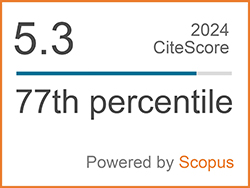A Perspective on Carbon Footprints and Carbon Reduction in Various Sectors
Abstract
Keywords
[1] A. Bumpus and S. Comello, “Emerging clean energy technology investment trends,” Nature Climate Change, vol. 7, no. 6, pp. 382–385, 2017.
[2] J. Deng et al., “Optimization strategies for the carbon footprint of aluminum-plastic materials under low-carbon targets,” Journal of Cleaner Production, vol. 498, p. 145182, 2025.
[3] R. Xu and B. Lin, “Why are there large regional differences in CO₂ emissions? Evidence from China’s manufacturing industry,” Journal of Cleaner Production, vol. 140, pp. 1330–1343, 2017.
[4] J. B. Skjærseth, “Towards a European Green Deal: The evolution of EU climate and energy policy mixes,” International Environmental Agreements: Politics, Law and Economics, vol. 21, no. 1, pp. 25–41, 2021.
[5] G. Liobikienė and J. Brizga, “Factors influencing carbon footprint in Latvian consumption: Environmental awareness and a socio-economic analysis,” Journal of Cleaner Production, vol. 489, p. 144664, 2025.
[6] O. Edenhofer, Climate Change 2014: Mitigation of Climate Change, vol. 3. Cambridge, UK: Cambridge University Press, 2015.
[7] A. EC, “Roadmap for moving to a competitive low carbon economy in 2050,” European Commission, Brussels, Belgium, 2011.
[8] EC. “WHITE PAPER roadmap to a single European transport area towards a competitive and resource efficient transport system.” European Commission. com. 2011. [Online]. Available: https://eur-lex.europa.eu/legal-content/ EN/TXT/?uri=CELEX:52011DC0144
[9] Y. Ou, Z. Bao, S. T. Ng, W. Song, and K. Chen, “Land-use carbon emissions and built environment characteristics: A city-level quantitative analysis in emerging economies,” Land Use Policy, vol. 137, p. 107019, 2024.
[10] G. Liu, F. Cui, and Y. Wang, “Spatial effects of urbanization, ecological construction and their interaction on land use carbon emissions/ absorption: Evidence from China,” Ecological Indicators, vol. 160, p. 111817, 2024.
[11] N. Shurpali, A. K. Agarwal, and V. K. Srivastava, “Introduction to greenhouse gas emissions,” in Greenhouse Gas Emissions: Challenges, Technologies and Solutions, Singapore: Springer, 2018, pp. 1–5.
[12] D. Liu, X. Guo, and B. Xiao, “What causes growth of global greenhouse gas emissions? Evidence from 40 countries,” Science of the Total Environment, vol. 661, pp. 750–766, 2019.
[13] W. F. Lamb et al., “A review of trends and drivers of greenhouse gas emissions by sector from 1990 to 2018,” Environmental Research Letters, vol. 16, no. 7, p. 073005, 2021.
[14] H. Ye et al., “Low-carbon behavior approaches for reducing direct carbon emissions: Household energy use in a coastal city,” Journal of Cleaner Production, vol. 141, pp. 128–136, 2017.
[15] M. Grote, I. Williams, and J. Preston, “Direct carbon dioxide emissions from civil aircraft,” Atmospheric Environment, vol. 95, pp. 214–224, 2014.
[16] L. Huang, G. Krigsvoll, F. Johansen, Y. Liu, and X. Zhang, “Carbon emission of global construction sector,” Renewable and Sustainable Energy Reviews, vol. 81, pp. 1906–1916, 2018.
[17] W. Meng, L. Xu, B. Hu, J. Zhou, and Z. Wang, “Quantifying direct and indirect carbon dioxide emissions of the Chinese tourism industry,” Journal of Cleaner Production, vol. 126, pp. 586–594, 2016.
[18] D. B. Muller, G. Liu, A. N. Løvik, R. Modaresi, S. Pauliuk, F. S. Steinhoff, and H. Brattebø, “Carbon emissions of infrastructure development,” Environmental Science & Technology, vol. 47, no. 20, pp. 11739–11746, 2013.
[19] S. Ala-Mantila, J. Heinonen, and S. Junnila, “Relationship between urbanization, direct and indirect greenhouse gas emissions, and expenditures: A multivariate analysis,” Ecological Economics, vol. 104, pp. 129–139, 2014.
[20] S. Ahmad, G. Baiocchi, and F. Creutzig, “CO₂ emissions from direct energy use of urban households in India,” Environmental Science & Technology, vol. 49, no. 19, pp. 11312–11320, 2015.
[21] Y. Ou, Z. Bao, S. T. Ng, W. Song, and K. Chen, “Land-use carbon emissions and built environment characteristics: A city-level quantitative analysis in emerging economies,” Land Use Policy, vol. 137, p. 107019, 2024.
[22] Q. Zhu, X. Peng, and K. Wu, “Calculation and decomposition of indirect carbon emissions from residential consumption in China based on the input–output model,” Energy Policy, vol. 48, pp. 618–626, 2012.
[23] N. Ma, H. Li, R. Tang, D. Dong, J. Shi, and Z. Wang, “Structural analysis of indirect carbon emissions embodied in intermediate input between Chinese sectors: A complex network approach,” Environmental Science and Pollution Research, vol. 26, pp. 17591–17607, 2019.
[24] A. Mofolasayo, “Assessing and managing the direct and indirect emissions from electric and fossil-powered vehicles,” Sustainability, vol. 15, no. 2, p. 1138, 2023.
[25] Ł. Sobol and A. Dyjakon, “The influence of power sources for charging the batteries of electric cars on CO₂ emissions during daily driving: A case study from Poland,” Energies, vol. 13, no. 16, p. 4267, 2020.
[26] A. Moro and L. Lonza, “Electricity carbon intensity in European Member States: Impacts on GHG emissions of electric vehicles,” Transportation Research Part D: Transport and Environment, vol. 64, pp. 5–14, 2018.
[27] J. Chen, Y. Lin, X. Wang, B. Mao, and L. Peng, “Direct and indirect carbon emission from household consumption based on LMDI and SDA model: A decomposition and comparison analysis,” Energies, vol. 15, no. 14, p. 5002, 2022.
[28] V. Filimonau, J. Dickinson, D. Robbins, and M. V. Reddy, “The role of ‘indirect’ greenhouse gas emissions in tourism: Assessing the hidden carbon impacts from a holiday package tour,” Transportation Research Part A: Policy and Practice, vol. 54, pp. 78–91, 2013.
[29] A. La Notte, S. Tonin, and G. Lucaroni, “Assessing direct and indirect emissions of greenhouse gases in road transportation, taking into account the role of uncertainty in the emissions inventory,” Environmental Impact Assessment Review, vol. 69, pp. 82–93, 2018.
[30] Y. Kazancoglu, M. Ozbiltekin-Pala, and Y. D. Ozkan-Ozen, “Prediction and evaluation of greenhouse gas emissions for sustainable road transport within Europe,” Sustainable Cities and Society, vol. 70, p. 102924, 2021.
[31] X. Ma, D. Chen, J. Lan, and C. Li, “The mathematical treatment for effect of income and urban-rural income gap on indirect carbon emissions from household consumption,” Environmental Science and Pollution Research, vol. 27, pp. 36231–36241, 2020.
[32] P. Diesing, G. Lopez, P. Blechinger, and C. Breyer, “From knowledge gaps to technological maturity: A comparative review of pathways to deep emission reduction for energy-intensive industries,” Renewable and Sustainable Energy Reviews, vol. 208, p. 115023, 2025.
[33] P. Glavič, Z. N. Pintarič, H. Levičnik, V. Dragojlović, and M. Bogataj, “Transitioning towards net-zero emissions in chemical and process industries: A holistic perspective,” Processes, vol. 11, no. 9, p. 2647, 2023.
[34] WNA, Carbon Dioxide Emissions From Electricity. World Nuclear Association, 2024.
[35] B. Linquist, K. J. Van Groenigen, M. A. Adviento‐Borbe, C. Pittelkow, and C. Van Kessel, “An agronomic assessment of greenhouse gas emissions from major cereal crops,” Global Change Biology, vol. 18, no. 1, pp. 194–209, 2012.
[36] R. Thangarajan, N. S. Bolan, G. Tian, R. Naidu, and A. Kunhikrishnan, “Role of organic amendment application on greenhouse gas emission from soil,” Science of the Total Environment, vol. 465, pp. 72–96, 2013.
[37] C. Yin, J. Wu, X. Sun, Z. Meng, and C. Lee, “Road transportation emission prediction and policy formulation: Machine learning model analysis,” Transportation Research Part D: Transport and Environment, vol. 135, p. 104390, 2024.
[38] A. Sikiru et al., “Methane emissions in cattle production: biology, measurement and mitigation strategies in smallholder farmer systems,” Environment, Development and Sustainability, pp. 1–24, 2024, doi: 10.1007/ s10668-024-04939-1.
[39] European Commission. “Road transport decarbonisation.” Climate Action. Accessed: Aug. 19, 2025. [Online]. Available: https://climate.ec.europa.eu/eu-action/transport-decarbonisation/road-transport_en
[40] European Commission. “Reducing emissions from aviation,” Climate Action. Accessed: Aug. 19, 2025. [Online]. Available: https://climate.ec. europa.eu/eu-action/transport-decarbonisation/reducing-emissions-aviation_en
[41] Sinay. “How much does the shipping industry contribute to global CO₂ emissions?.” sinay.ai. Accessed: Aug. 19, 2025. [Online]. Available: https://sinay.ai/en/how-much-does-the-shipping-industry-contribute-to-global-co2-emissions
[42] Clean Cooking Alliance. “Climate and environment.” cleancooking.org. Accessed: Aug. 19, 2025. [Online]. Available: https://cleancooking.org/ the-issues/climate-environment
[43] L. Wang, “Assessment of land use change and carbon emission: A Log Mean Divisa (LMDI) approach,” Heliyon, vol. 10, no. 3, 2024, Art. no. E25669.
[44] J. Cui and Y. Wu, “Calculation and influencing factors of carbon emissions in countries along the Belt and Road based on the LMDI method,” Highlights in Science, Engineering and Technology, vol. 11, pp. 167–176, 2022.
[45] H. Pan et al., “Toward sustainable crop production in China: A co-benefits evaluation,” Journal of Cleaner Production, vol. 361, p. 132285, 2022.
[46] P. Wu, Y. Song, J. Zhu, and R. Chang, “Analyzing the influence factors of the carbon emissions from China’s building and construction industry from 2000 to 2015,” Journal of Cleaner Production, vol. 221, pp. 552–566, 2019.
[47] Z. Liu et al., “Features, trajectories and driving forces for energy-related GHG emissions from Chinese mega cities: The case of Beijing, Tianjin, Shanghai and Chongqing,” Energy, vol. 37, no. 1, pp. 245–254, 2012.
[48] R. Li, Q. Wang, Y. Liu, and R. Jiang, “Per-capita carbon emissions in 147 countries: the effect of economic, energy, social, and trade structural changes,” Sustainable Production and Consumption, vol. 27, pp. 1149–1164, 2021.
[49] C. Lu, W. Li, and C. An, “The GHG emission determinants research for waste disposal process at city-scale in Baoding,” Sustainable Cities and Society, vol. 59, p. 102203, 2020.
[50] UNEP. “Building materials and climate: Constructing a new future.” UNEP. Accessed: Aug. 19, 2025. [Online]. Available: https://www.unep.org/resources/report/building-materials-and-climate-constructing-new-future
[51] NRDC. “Fossil fuels: The dirty facts.” Natural Resources Defense Council, Accessed: Aug. 19, 2025. [Online]. Available: https://www.nrdc.org/ stories/fossil-fuels-dirty-facts
[52] L. Jing, H. M. El-Houjeiri, J.-C. Monfort, A. R. Brandt, M. S. Masnadi, D. Gordon, and J. A. Bergerson, “Carbon intensity of global crude oil refining and mitigation potential,” Nature Climate Change, vol. 10, no. 6, pp. 526–532, 2020.
[53] T. Lei et al., “Adaptive CO₂ emissions mitigation strategies of global oil refineries in all age groups,” One Earth, vol. 4, no. 8, pp. 1114–1126, 2021.
[54] Z. Zhang, T. N. G. Borhani, and M. H. El-Naas, “Carbon capture,” in Exergetic, Energetic and Environmental Dimensions, New York: Academic Press, 2018, pp. 997–1016.
[55] A. Lakhouit, “Mitigating landfill emissions strategies for effective waste management in Tabuk,” Cleaner Waste Systems, vol. 9, p. 100187, 2024.
[56] Considerate Consumer. “Carbon footprint.” Considerate Consumer, Accessed: Aug. 19, 2025. [Online]. Available: https://www.considerate- consumer.com/carbon-footprint
[57] A. Watabe and A. M. Yamabe-Ledoux, “Low-carbon lifestyles beyond decarbonisation: Toward a more creative use of the carbon footprinting method,” Sustainability, vol. 15, no. 5, p. 4681, 2023.
[58] J. P. Juanga-Labayen, I. V. Labayen, and Q. Yuan, “A review on textile recycling practices and challenges,” Textiles, vol. 2, no. 1, pp. 174–188, 2022.
[59] U.S. Department of Energy. “Lighting choices to save you money.” Energy.gov, Accessed: Aug. 19, 2025. [Online]. Available: https://www.energy. gov/energysaver/lighting-choices-save-you-money
[60] European Youth Portal. “How to reduce my carbon footprint.” European Union. Accessed: Aug. 19, 2025. [Online]. Available: https://youth. europa.eu/get-involved/sustainable-development/ how-reduce-my-carbon-footprint_en
[61] I. Raheem et al., “A comprehensive review of approaches in carbon capture, and utilization to reduce greenhouse gases,” Applied Science and Engineering Progress, vol. 18, no. 2, 2025, Art. no. 7629, doi: 10.14416/j.asep.2024.11.004.
[62] O. M. Abioye et al., “An overview of the role of vermicompost in reducing green house gas emissions, improving soil health, and increasing crop yields,” Applied Science and Engineering Progress, vol. 18, no. 2, 2025, Art. no. 7586, doi: 10.14416/j.asep.2024.09.011.DOI: 10.14416/j.asep.2025.09.010
Refbacks
- There are currently no refbacks.
 Applied Science and Engineering Progress
Applied Science and Engineering Progress







